Photo Gallery: Summer Fest At The Ole Mill Pond
June 16, 2012
Summer Fest at the Ole Mill Pond was held Friday afternoon at Century Care Center. Local vendors were on hand selling their wares and there was live entertainment and more.
For a photo gallery from the event, click here.
Submitted photos for NorthEscambia.com, click to enlarge.
Obama Administration To Stop Deporting Some Young Illegal Immigrants (With Video)
June 16, 2012
The Obama Administration announced Friday that nearly 800,000 “dreamers” – undocumented children who grew up here – won’t face deportation but be offered at least temporary safe harbor in the United States, bringing reaction from all sides on an issue that has long vexed the nation and Congress.
 Speaking to reporters from the White House Friday afternoon, President Barack Obama said the Department of Homeland Security would immediately adopt a set of guidelines that would allow the children of illegal immigrants to stay in the United States in many cases.
Speaking to reporters from the White House Friday afternoon, President Barack Obama said the Department of Homeland Security would immediately adopt a set of guidelines that would allow the children of illegal immigrants to stay in the United States in many cases.
Called “Dreamers,” for the “Dream Act” proposals that have sought to provide a path to college for “American” children of undocumented immigrants, the group includes children and young adults who came to the United States before they turned 16 and consider their adopted country home. Many, in fact, do not remember living in their native country and have forgotten or never acquired the language of their parents.
In the meantime, they have grown up going to U.S. schools, working in U.S. jobs and sometimes fighting in U.S. wars, all the while facing potential deportation because their parents brought them into the country illegally.
“They are Americans in their hearts, in their minds and in every other way but one, on paper,” Obama said.
(Article continues below video, scroll down.)
The directive gives immigration officials the right to focus their attentions elsewhere without actually changing the law. The rule sets out a number of criteria, limiting the protections to people under 30 who were brought to the U.S. before they turned 16. To qualify, they must also have been enrolled in school, lived at least five consecutive years in the country and have no criminal record.
Congress has been wrangling over the Dream Act for several years but has failed to act, Obama said Friday, in explaining in part why the administration was stepping in. Earlier Friday, DHS Secretary Janet Napolitano announced the change in policy, which can go into effect without congressional approval.
Reaction to the new rule and Obama’s announcement was immediate.
“Today’s announcement will be welcome news for many of these kids desperate for an answer, but it is a short term answer to a long term problem,” Florida U.S. Sen. Marco Rubio said in a statement. “And by once again ignoring the Constitution and going around Congress, this short term policy will make it harder to find a balanced and responsible long term one.”
GOP presidential candidate Mitt Romney, agreed.
“If I’m president, we’ll do our very best to have that long-term solution,” Romney told reporters during a campaign stop in New Hampshire. “An executive order is, of course, just a short-term matter that can be reversed by subsequent presidents.”
“I’m extremely disappointed the President has chosen to circumvent the Legislative Branch in an election year attempt to implement a policy he couldn’t get through Congress. This action is an enormous power grab by the Executive Branch and completely disregards the rule of law. It effectively bypasses Congress and grants what is essentially amnesty for a portion of the illegal immigrant population,” Rep. Jeff Miller said.
“The Obama Administration’s attempt to completely bypass the policy of an elected Congress is a tremendous breach of trust with the American people and seriously threatens the separation of powers so fundamental to our democracy. Further, I feel this action will negatively impact the scores of unemployed Americans who are currently looking for jobs,” Miller continued
Interviewed by “The Hill” newspaper, U.S. Rep. Allen West (R-Fla.) said he’s concerned that the effort could be used as a “backdoor” to ultimately allow non-citizens to vote, either this fall or in the future.
“How far down the rabbit hole will it go?” West asked.
Other groups offered unequivocal support.
The National Association of Latino Elected and Appointed Officials praised the move for recognizing the contributions of immigrants to improve their adopted home.
“The Administration’s directive recognizes that law-abiding immigrant youth who are currently in school, or have completed their high school education or served in the military and meet several other key criteria should be provided protection from removal and the ability to seek gainful employment in the United States,” the group said.
By The News Service of Florida
NWE 9-10U Beats Evergreen, Advances In District Tournament
June 16, 2012
Northwest Escambia’s 9-10U All Star team defeated Evergreen Friday night 17-7 to advance in the 2012 All Star District Tournament in Evergreen, AL.
NWE will play Opp at 4:00 Saturday afternoon at Evergreen Municipal Park.
Pictured: The NWE 9-10U All Stars Friday night in Evergreen, AL. Photo by Michelle Thomas for NorthEscambia.com, click to enlarge.
Tate High Recognizes Scholarship, Special Award Recipients
June 16, 2012
Tate High School presented or recognized the following special awards or scholarships for members of the Class of 2012 recently:
- Matthew Warren – University of Alabama Engineering Scholarship
- Daniel Pierce – Florida State University College of Medicine Scholarship
- Daniel Pierce and Tatiana Teate – Take Stock In Children Scholarship
- Chase Carroll – Wings Over America (US Navy) Scholarship
- Rhett Chancellor – National Merit Letter of Commendation
- Courtney Graves – Future Educators of America Scholarship (also 2 other Education-related scholarships)
- Jasmine Baldwin – MLK Scholarship from International Paper for Florida A&M University
- Antonio Odom – Pensacola Civitan of the Year
- Sarah Barlow, Asia Cravens and Tatiana Teate – Received a Congressional Record from Jeff Miller in honor of the Mock Trial Team winning the Florida State Championship
- Pensacola Interstate Fair Educational Grant Recipients: Chase Carroll, Katelyn Clairain, Morgan Geary and Megan Gibbs
Voter Registration Deadline Approaching For August Primary Election
June 16, 2012
Escambia County Supervisor of Elections David H. Stafford is reminding voters that Monday, July 16 will be the last day to register to vote or change party affiliation for those who wish to cast a ballot in the August 14 Primary Election.
Florida law mandates that registration books close 29 days before an election. New registrations must be completed on or before the end of the business day on July 16 in order for them to be effective for the August 14 election. Address changes can be made after the books close. If you are unsure of your registration status, visit EscambiaVotes.com and click “Am I Registered?”.
Escambia County citizens have several ways to register or update their record:
Online/By Mail: Visit EscambiaVotes.com and complete, print, and sign the online application. Be sure to include a valid Florida Driver’s License number, a valid Florida ID number, or the last 4 digits of your Social Security Number in the appropriate space. Completed applications must be received no later than July 16 to: Escambia County Supervisor of Elections, PO Box 12601, Pensacola, FL 32591-2601. Or, take the completed application to the Elections Office at 213 Palafox Place, 2nd Floor, in downtown Pensacola. Also, to have a form mailed to you, call (595-3900) or e-mail the Elections Office (soe@escambiavotes.com).
In Person: You can register at the Elections Office at 213 Palafox Place, 2nd Floor, in downtown Pensacola, at any Florida Driver’s License Office, and several other governmental offices and public assistance centers. Registration forms are also available to pick up at many locations countywide. For a complete list of locations throughout Escambia County, visit EscambiaVotes.com or call or e-mail the Elections Office.
For voters who wish to cast a ballot by mail (an absentee ballot), go to EscambiaVotes.com and complete the online request form, or call or e-mail the elections office. Early voting begins August 4 at several locations throughout Escambia County.
Weekend Gardening: Tomato Pests
June 16, 2012
June is prime time for growing tomatoes here in Escambia County, but it’s also the best time to see a lot of pests in tomatoes that can totally ruin a crop. To help you figure out what’s “bugging” your tomatoes, here’s a quick rundown of some of the pests that you might see in your garden. Much of the information in this article was adapted from the University of Florida EDIS (Electronic Data Information Source) publication Insect Management for Tomatoes, Peppers, and Eggplant. Management techniques for the pests will be found in the full publication.
Click any photo to enlarge.
Silverleaf Whitefly
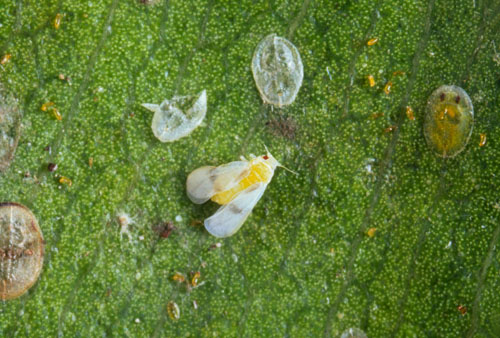 The adult silverleaf whitefly is small, approximately 1/16 of an inch in length, and has powdery white wings held tent-like while at rest over a yellow body. Whiteflies are usually found on the undersides of leaves. Eggs, which are yellow and football-shaped, are attached upright by a tiny stalk inserted into the lower leaf surface. A mobile first instar (growth stage), or crawler stage, hatches from the egg and settles on the leaf. It then develops through immobile second, third, and fourth instars which look like semi-transparent, flat, oval scales. The fourth instar or “pupa” is more yellow and more easily seen without the aid of a hand lens, and typically has very distinct eyespots, and is referred to as a “red-eyed nymph.”
The adult silverleaf whitefly is small, approximately 1/16 of an inch in length, and has powdery white wings held tent-like while at rest over a yellow body. Whiteflies are usually found on the undersides of leaves. Eggs, which are yellow and football-shaped, are attached upright by a tiny stalk inserted into the lower leaf surface. A mobile first instar (growth stage), or crawler stage, hatches from the egg and settles on the leaf. It then develops through immobile second, third, and fourth instars which look like semi-transparent, flat, oval scales. The fourth instar or “pupa” is more yellow and more easily seen without the aid of a hand lens, and typically has very distinct eyespots, and is referred to as a “red-eyed nymph.”
As the plant grows, leaves bearing the maturing nymphs are found lower down on the plant, so older nymphs can be found by looking at older leaves. Whiteflies ingest sap from the plant vascular system (phloem) through stylets similar to those of aphids and, like aphids, process a relatively large volume of plant sap by excreting excess liquid in the form of a sugary substance called honeydew. The honeydew will result in sooty mold—a black, powdery looking substance that reduces photosynthesis in the leaves. Sometimes the nymphs will feed on the fruit and that will cause white tissue on the inside of the fruit walls.
Aphids
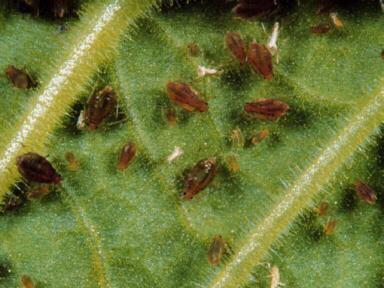 Aphids are soft-bodied, sucking insects that can rapidly colonize plants due to their short life cycle. Adults are delicate, pear- or spindle-shaped insects with a posterior pair of tubes (cornicles), which project upward and backward from the end of the abdomen and which are used for excreting a defensive fluid. In Florida, winged and wingless forms are all female and give birth to living young (nymphs). Nymphs are smaller but otherwise similar in appearance to wingless adults, which they become in 7 to 10 days.
Aphids are soft-bodied, sucking insects that can rapidly colonize plants due to their short life cycle. Adults are delicate, pear- or spindle-shaped insects with a posterior pair of tubes (cornicles), which project upward and backward from the end of the abdomen and which are used for excreting a defensive fluid. In Florida, winged and wingless forms are all female and give birth to living young (nymphs). Nymphs are smaller but otherwise similar in appearance to wingless adults, which they become in 7 to 10 days.
Heavy aphid infestations may cause stunting and leaf distortion. Feeding on blossoms reduces fruit set. Sooty mold will grow on the honeydew that the aphids excrete. Aphids may also spread plant viruses.
Brown and Green Stink Bugs and Leaf-footed bugs
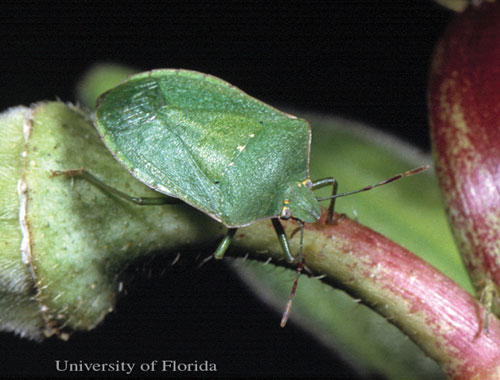 Like aphids and whiteflies, true bugs are sucking insects. True bugs can be recognized by their front wings, which are leathery close to the body but membrane-like at the tips. Nymphs resemble adults in shape but are often colored differently and do not have fully developed wings. Stink bugs are green or brown shield-shaped bugs 1/2 to 2/3 of an inch long. Eggs are barrel-shaped and found on the undersides of leaves in masses of 10 to 50.
Like aphids and whiteflies, true bugs are sucking insects. True bugs can be recognized by their front wings, which are leathery close to the body but membrane-like at the tips. Nymphs resemble adults in shape but are often colored differently and do not have fully developed wings. Stink bugs are green or brown shield-shaped bugs 1/2 to 2/3 of an inch long. Eggs are barrel-shaped and found on the undersides of leaves in masses of 10 to 50.
Leaf-footed bugs are dark-colored true bugs with parallel sides. Eggs are metallic and ovate but somewhat flattened laterally and laid in clusters. Some leaf-footed bugs lay their eggs end-to-end in a single row or chain along a stem or leaf midrib. Nymphs are oblong in shape and red in color, especially on the abdomen.
Nymphs and adults of both stink bugs and leaf-footed bugs suck juices from green fruit leaving a puncture which later may become surrounded by a discolored zone due to invasion of secondary pathogens. Stink bug feeding punctures are often surrounded with a lightened, sometimes depressed, blotch beneath the fruit surface caused by the removal of cell contents and the enzymes injected by the bug. Leaf-footed punctures may cause fruit to become distorted as they enlarge
Tomato Hornworm
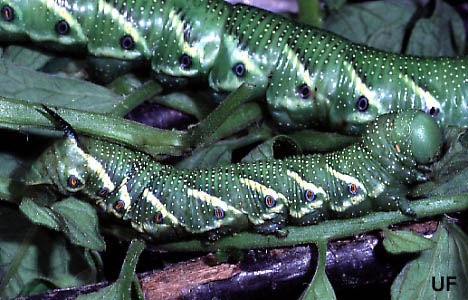 There are many caterpillars that can feed on tomatoes but the tomato hornworm can strip a plant of leaves in a few days. The adult moth is large with mottled brown forewings that are longer than the lighter brown hind wings. The sides of the abdomen have five yellow spots on the sides. The female moth will lay eggs on the upper and lower surfaces of leaves. The adult moths are nectar feeders on many flowers and may be seen in the early evening around gardens and flowers.
There are many caterpillars that can feed on tomatoes but the tomato hornworm can strip a plant of leaves in a few days. The adult moth is large with mottled brown forewings that are longer than the lighter brown hind wings. The sides of the abdomen have five yellow spots on the sides. The female moth will lay eggs on the upper and lower surfaces of leaves. The adult moths are nectar feeders on many flowers and may be seen in the early evening around gardens and flowers.
The emerging caterpillars will feed on leaves and go through several molts as they develop into large green caterpillars with a black ‘horn’ on the tip of the abdomen. Caterpillars are also identified by the white or yellow ‘V’ marks on the sides of the abdomen. When it is time to pupate, the caterpillars drop to the soil and make a cell for changing to the adult moth. The pupa is reddish brown and has a loop structure at the head that contains the mouthparts. There are normally two generations of tomato hornworm a year and as late summer arrives, the hornworm goes through a resting phase.
Other plants in the tomato family can be eaten by tomato hornworms but tomatoes are the favorite in our area. The caterpillars will eat entire leaves and initially work their down on the plant, eating leaves, blossoms, and even green fruit. Because they blend in with green foliage, a homeowner will often overlook the caterpillar despite its large size.
Hornworm does have natural enemies so be cautious before reaching for the insecticide. They can also be easily handpicked and destroyed after you find them.
If you would like further information, please contact the Escambia County Extension office, (850) 475-5230.
Farm Fresh: Cantonment Market Open
June 16, 2012
 The Market at St. Monica’s will be open Saturday in Cantonment offering a wide variety of farm fresh produce, plants, crafts and other products.
The Market at St. Monica’s will be open Saturday in Cantonment offering a wide variety of farm fresh produce, plants, crafts and other products.
The Market at Saint Monica’s will be held from 8 a.m. until 1 p.m. at the church, located at 699 South Highway 95A in Cantonment.
Vendors are expected to sell a variety of items Saturday, including: corn, peas, tomatoes, beans, potatoes, fresh eggs, mayhaw berries and jellies, hot dogs, pop corn, paintings, herbs, potted plants, sewn items, Mennonite baked goods, home decor, homemade quilts, goat milk soap and more.
For more information, visit www.st-monicas.org/market.html.
Pictured: A portion of the produce available at the June 2 edition of the Market at St. Monica’s. Courtesy photo for NorthEscambia.com, click to enlarge.
Blue Wahoos Split Twin Bill With Mobile
June 16, 2012
The Blue Wahoos split their double header against the BayBears, with Mobile winning the resumption of last night’s suspended game 4-1, while Pensacola defeated the BayBears 3-2 in the second game, in front of sellout crowds of 5,038 on Friday night at Pensacola Bayfront Stadium.
The Fish have now won six of their last seven contests and own a 33-34 record this year, while Mobile moved their 2012 mark to 39-29. Their victory, combined with a Montgomery Biscuit loss to the Huntsville Stars tonight clinched a first half title in the South Division of the Southern League. The two capacity crowds now raises Pensacola’s total to 21 sellout crowds this year, with the Blue Wahoos continuing to lead the league in attendance.
After both clubs combined for four home runs last night, including three straight from Mobile RF Marc Krauss, C Ed Easley and 1B Yazy Arbelo, as well as a solo shot by 1B Joel Guzman before inclement weather suspended the game, the BayBears plated an additional insurance run in the ninth after the game resumed Friday night. Easley began the ninth with a single and advanced to third on a base knock, before scoring on a sacrifice fly to center by SS Wladimir Sutil.
Mobile reliever Bryan Woodall (2.1 IP, 2 H, 2 BB) earned the win after giving up just two hits in 2.1 scoreless innings of work, while Blue Wahoos starter Tony Cingrani (5.0 IP, 4 H, 3 R, 3 ER, 6 SO) suffered the loss to fall to 1-1 after yielding three earned runs on four hits while fanning six in five frames. BayBears closer Evan Marshall (1.0 IP, 1 H, 1 SO) pitched a shutout final frame to notch his 14th save of the year.
Arbelo (3-4, 1 R, 1 HR, 1 RBI) led all batters with three hits for the BayBears, while Easley (2-4, 2 R, 1 HR, 1 RBI) tallied a multi-hit effort. 2B Brodie Greene (2-3, 1 2B, 1 BB) was the lone Pensacola batter to record two hits in the first contest.
The Blue Wahoos struck first in the second half of the twin bill, scoring two in the second. Following a leadoff double by 1B Joel Guzman, 3B David Vidal was hit by a pitch, with both moving an additional thanks to a sacrifice bunt, before Guzman was sent in with a sacrifice fly by C Mark Fleury. Vidal would subsequently score on an RBI single by starting pitcher J.C. Sulbaran with the first of his two hits in the game.
The advantage grew to 3-0 in the following frame after 2B Brodie Greene doubled and moved to third on a wild pitch before he was brought home on another Blue Wahoos sacrifice fly, this one to right off the bat of Vidal.
Mobile did not go down quietly however, scoring two runs in the sixth. RF Marc Krauss drew a free pass, while 3B Matt Davidson singled and Arbelo was plunked to load the bases for LF Dan Kavzrowski, who drove home Krauss and Davidson with a single to left. The BayBears threatened for more, but the Fish were able to induce an inning-ending double play to hold on to their lead.
Sulbaran (5.1 IP, 3 H, 2 R, 1 ER, 3 BB, 6 SO) earned the win to improve to 5-4 this year after allowing just two runs, one of which was earned, on three hits in 5.1 frames, while reliever Curtis Partch (1.2 IP, 1 H, 1 BB, 1 SO) notched his second save after firing the final 1.2 innings. Mobile starter Brett Lorin (4.2 IP, 6 H, 3 R, 3 ER, 5 BB) suffered the loss after giving up three runs on six hits in 4.2 frames.
Guzman (2-2, 1 R, 1 2B, 1 BB) collected a pair of base hits in the second contest to lead Pensacola, while Davidson (2-3, 1 R) tallied two base knocks for the BayBears as the only players to record a multi-hit contest.
The Blue Wahoos and BayBears will square off again Saturday night at the bayfront stadium, with first pitch scheduled for 6:30 pm. Pensacola is expected to give the ball to RHP Daniel Corcino, while LHP David Holmberg is slated to get the nod for Mobile.
By Andrew Green
Florida Inmates Spend More Time Behind Bars Than Other States
June 16, 2012
Criminal justice experts say they weren’t surprised by last week’s study showing that the time Florida prisoners spend behind bars has grown more than in any other state – a 166 percent increase in the average sentence between 1990 and 2009.
Former Department of Corrections Secretary James McDonough ascribed the findings of the report, “Time Served: The High Cost, Low Return of Longer Prison Terms” by the Pew Center on the States to changes in Florida statutes during the mid-to-late 1990’s.
He cited 1995’s “Truth in Sentencing” law, requiring inmates to serve at least 85 percent of their sentences, and two 1999 laws: “Three Strikes,” by which a third felony conviction requires a minimum sentence of 25 years to life if someone is injured or killed, and “10-20-Life,” which established mandatory minimum sentences for crimes involving firearms.
“Politics in Florida has been such that public officials are afraid to appear, quote, ‘weak on crime,’” McDonough said. “And the way that’s defined is, ‘Don’t lighten up on the sentencing in any way whatsoever.’”
He said the state’s prison terms jumped so much, so fast because in 1990, Florida inmates were serving just 30 percent of their sentences.
“We had prison overcrowding at that time, so we came up with a parole policy and a probation policy that really let a lot of inmates out much, much too early,” McDonough said. “So the pendulum had swung one way. And then throughout the 90’s and the last ten years, we saw the pendulum swing … the other way.
“So you came up with a series of laws and policies that brought us up to this incredible increase in length of stay.”
The state’s position is that such laws have reduced crime immensely.
“Tough-on-crime initiatives have successfully reversed the lenient and disastrous criminal-justice policies of the early 1990s in Florida that caused so much suffering,” notes the DOC web site. “Thanks to the dedication of our state’s law enforcement officers, correctional officers and state prosecutors who enforce tough laws like 10-20-LIFE, Florida’s ‘Index Crime’ rate was the lowest in 34 years and the violent crime rate is the lowest in a quarter century.”
Crime has been dropping for decades, but Florida’s inmate population has risen by a factor of five over 30 years, during which time the general population has barely doubled. As of June 30, 1990, Florida prisons housed 42,733 offenders; by June 30, 2011, the figure was 102,319.
During the period examined by the study, Florida sentences for violent crimes increased from 2.1 years to 5 years, or 137 percent, while drug-related sentences rose 194 percent, from an average of 0.8 years to 2.3 years.
The 166 percent increase in the average prison sentence cost Florida taxpayers $1.4 billion in 2009, according to Pew.
Meanwhile, most states have embraced the concept of “smart justice,” said prison chaplain Allison DeFoor, a former judge and sheriff. “Smart justice” is a compendium of performance measures, accountability and transparency designed to keep inmates from returning to prison after their release.
Fully one-third of Florida offenders return to prison within five years, DeFoor said. “That’s not an efficient system…We talk about recidivism like it’s an intellectual concept. Well, every new [act of] recidivism is somebody’s grandmother’s house got broken into or their car got jacked.”
Florida’s “smart justice” proponents have tried, for instance, to reduce sentences for non-violent offenders. Sen. Ellyn Bogdanoff, R-Fort Lauderdale, repeatedly sponsored a measure that would have ended mandatory minimum sentences for drug offenders, who would remain in custody during the rehabilitation portion of their sentences. She said many addicts have mental health issues that cause them to self-medicate, and that with treatment, they can become taxpayers instead of inmates.
But while the Senate passed Bogdanoff’s bill 40-0 and the House 112-4, Gov. Rick Scott vetoed the measure, saying it would be an injustice to victims.
“Justice to victims of crime is not served when a criminal is permitted to be released early from a sentence imposed by the courts,” he wrote in his veto message. “This bill would permit criminals to be released after serving 50 percent of their sentences, thus creating an unwarranted exception to the rule that inmates serve 85 percent of their imposed sentences.”
As to the Pew study, DOC spokeswoman Ann Howard said the agency wasn’t involved in the research, “so we will refrain from comment out of respect and etiquette to the researchers.”
“The department’s only role is to execute the court orders, added DOC spokeswoman Jo Ellyn Rackleff. “The judges apply the sentences according to Florida statutes, which are passed by the Legislature.”
Pew examined nonviolent offenders released in 2004, concluding that 14 percent of all offenders released in Florida could have served shorter sentences with no threat to public safety.
DeFoor said the most important thing about the study is that it measures the evidence. “It’s ultimately got to be about accountability,” he said. “We need to be driven by the data, not by emotional reactions on either side.”
By The News Service of Florida
Escambia County’s $9.6 Million Budget Dilemma Solved
June 15, 2012
The Escambia County Commission received good news this morning — what was a $9.6 million budget deficit has been cut dramatically without any tax increase.
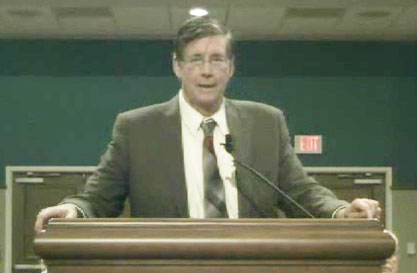 The current deficit, according to County Administrator Randy Oliver, is down to $410,382. After planned retirement buyouts, that deficit drops to $264,855. The improved budget was based in part on an estimated $2.4 million increase in ad valorem tax collections and on cost reductions across the board.
The current deficit, according to County Administrator Randy Oliver, is down to $410,382. After planned retirement buyouts, that deficit drops to $264,855. The improved budget was based in part on an estimated $2.4 million increase in ad valorem tax collections and on cost reductions across the board.
The commission decided Thursday to eliminate four positions to make up the $264,000. But before the employees get their pink slips, the county will ask the Escambia County Health Facilities Authority for the $264,000 to offset the funding of Escambia County Community Clinics.
The county faced a budget crisis after a state mandate that the county pay for 10 years of Medicaid bills, about $6 million. The library systems was one of the first potential targets to save cash, but branch libraries were spared after public outcry.
“Escambia County anticipated a $3.4 million deficit. However, when the State of Florida passed down the unfunded $6.1 million Medicaid mandate to local government, we were faced with closing a $9.6 million dollar shortfall,” Oliver said. “Actions proposed by the staff – and approved by the Board of County Commissioners – has addressed this deficit in a prudent manner and resulted in a balanced budget without using general fund reserves.”
The library systems was one of the first potential targets to save cash, but branch libraries were spared after public outcry. Library funding does take a 5-percent cut under the proposed budget, but there is a stipulation that all libraries in the unincorporated areas of the county must continue to operate in the same manner as the other branch libraries, including hours of operation. That stipulation includes the Molino Branch which will open later this year.
Pictured: Escambia County Administrator Randy Oliver addresses the Escambia County Commission Thursday morning. Courtesy photo for NorthEscambia.com, click to enlarge.







